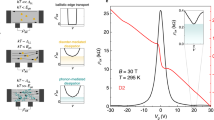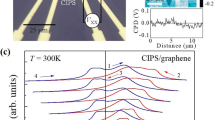Abstract
When electrons are confined in two-dimensional materials, quantum-mechanically enhanced transport phenomena such as the quantum Hall effect can be observed. Graphene, consisting of an isolated single atomic layer of graphite, is an ideal realization of such a two-dimensional system. However, its behaviour is expected to differ markedly from the well-studied case of quantum wells in conventional semiconductor interfaces. This difference arises from the unique electronic properties of graphene, which exhibits electron–hole degeneracy and vanishing carrier mass near the point of charge neutrality1,2. Indeed, a distinctive half-integer quantum Hall effect has been predicted3,4,5 theoretically, as has the existence of a non-zero Berry's phase (a geometric quantum phase) of the electron wavefunction—a consequence of the exceptional topology of the graphene band structure6,7. Recent advances in micromechanical extraction and fabrication techniques for graphite structures8,9,10,11,12 now permit such exotic two-dimensional electron systems to be probed experimentally. Here we report an experimental investigation of magneto-transport in a high-mobility single layer of graphene. Adjusting the chemical potential with the use of the electric field effect, we observe an unusual half-integer quantum Hall effect for both electron and hole carriers in graphene. The relevance of Berry's phase to these experiments is confirmed by magneto-oscillations. In addition to their purely scientific interest, these unusual quantum transport phenomena may lead to new applications in carbon-based electronic and magneto-electronic devices.
This is a preview of subscription content, access via your institution
Access options
Subscribe to this journal
Receive 51 print issues and online access
$199.00 per year
only $3.90 per issue
Buy this article
- Purchase on Springer Link
- Instant access to full article PDF
Prices may be subject to local taxes which are calculated during checkout



Similar content being viewed by others
References
Semenoff, G. W. Condensed-matter simulation of a three-dimensional anomaly. Phys. Rev. Lett. 53, 2449–2452 (1984)
Haldane, F. D. M. Model for a quantum hall effect without Landau levels: condensed-matter realization of the “parity anomaly”. Phys. Rev. Lett. 61, 2015–2018 (1988)
Zheng, Y. & Ando, T. Hall conductivity of a two-dimensional graphite system. Phys. Rev. B 65, 245420 (2002)
Gusynin, V. P. & Sharapov, S. G. Unconventional integer quantum Hall effect in graphene. Preprint at http://xxx.lanl.gov/abs/cond-mat/0506575 (2005).
Peres, N. M. R., Guinea, F. & Neto, A. H. C. Electronic properties of two-dimensional carbon. Preprint at http://xxx.lanl.gov/abs/cond-mat/0506709 (2005).
Ando, T., Nakaishi, T. & Saito, R. Berry's phase and absence of back scattering in carbon nanotubes. J. Phys. Soc. Jpn. 67, 2857–2862 (1998)
Mikitik, G. P. & Sharlai, Y. V. Manifestation of Berry's phase in metal physics. Phys. Rev. Lett. 82, 2147–2150 (1999)
Novoselov, K. S. et al. Electric field effect in atomically thin carbon films. Science 306, 666–669 (2004)
Berger, C. et al. Ultrathin epitaxial graphite: 2D electron gas properties and a route toward graphene-based nanoelectronics. J. Phys. Chem. B 108, 19912–19916 (2004)
Zhang, Y., Small, J. P., Pontius, W. V. & Kim, P. Fabrication and electric-field-dependent transport measurements of mesoscopic graphite devices. Appl. Phys. Lett. 86, 073104 (2005)
Zhang, Y., Small, J. P., Amori, E. S. & Kim, P. Electric field modulation of galvanomagnetic properties of mesoscopic graphite. Phys. Rev. Lett. 94, 176803 (2005)
Bunch, J. S., Yaish, Y., Brink, M., Bolotin, K. & McEuen, P. L. Coulomb oscillations and Hall effect in quasi-2D graphite quantum dots. Nano Lett. 5, 287–290 (2005)
Roukes, M. L., Scherer, A. & Van der Gaag, B. P. Are transport anomalies in ‘electron waveguides’ classical? Phys. Rev. Lett. 64, 1154–1157 (1990)
Fang, Z. et al. The anomalous Hall effect and magnetic monopoles in momentum space. Science 302, 92–95 (2003)
McEuen, P. L., Bockrath, M., Cobden, D. H., Yoon, Y. & Louie, S. G. Disorder, pseudospins, and backscattering in carbon nanotubes. Phys. Rev. Lett. 83, 5098–5101 (1999)
Sharapov, S. G., Gusynin, V. P. & Beck, H. Magnetic oscillations in planar systems with the Dirac-like spectrum of quasiparticle excitations. Phys. Rev. B 69, 075104 (2004)
Luk'yanchuk, I. A. & Kopelevich, Y. Phase analysis of quantum oscillations in graphite. Phys. Rev. Lett. 93, 166402 (2004)
Morozov, S. V. et al. Two dimensional electron and hole gases at the surface of graphite. Preprint at http://xxx.lanl.gov/abs/cond-mat/0505319 (2005).
Shoenberg, D. Magnetic Oscillation in Metals (Cambridge Univ. Press, Cambridge, 1984)
Kane, C. L & Mele, E. J. Quantum spin Hall effect in graphene. Preprint at http://xxx.lanl.gov/abs/cond-mat/0411737 (2005).
Acknowledgements
We thank I. Aleiner, A. Millis, T. F. Heinz, A. Mitra, J. Small and A. Geim for discussions. This research was supported by the NSF Nanoscale Science and Engineering Center at Columbia University, New York State Office of Science (NYSTAR) and the Department of Energy (DOE).
Author information
Authors and Affiliations
Corresponding author
Ethics declarations
Competing interests
Reprints and permissions information is available at npg.nature.com/reprintsandpermissions. The authors declare no competing financial interests.
Supplementary information
Supplementary Discussion
This pdf formatted file contains detailed discussions of sample preparation method, cross-correlation of optical microscope and AFM images of single layer and few layer graphene samples, and electrical characterization of double layer graphene samples. (PDF 203 kb)
Rights and permissions
About this article
Cite this article
Zhang, Y., Tan, YW., Stormer, H. et al. Experimental observation of the quantum Hall effect and Berry's phase in graphene. Nature 438, 201–204 (2005). https://doi.org/10.1038/nature04235
Received:
Accepted:
Issue Date:
DOI: https://doi.org/10.1038/nature04235
This article is cited by
-
Three-dimensional flat Landau levels in an inhomogeneous acoustic crystal
Nature Communications (2024)
-
Twenty years of 2D materials
Nature Physics (2024)
-
Fabrication of sub-20 nm MoS2 horizontal nanowire on silicon substrates by inclusion of precursors into polystyrene-b-polyethylene oxide nanopatterns: Detailed structural investigation
Nano Research (2024)
-
Long-range ordered graphitic structure in silk fibers delaminated using dopamine and thermal treatment for super-flexible electronic textiles: Possible applications for magnetic and thermoelectric textiles
Advanced Composites and Hybrid Materials (2024)
-
Effect of Line Defects on the Band Structures, Local Density of States, and the Landau Levels for Armchair Graphene Nanoribbons in the Quantum Hall Effect Regime
Journal of Electronic Materials (2024)
Comments
By submitting a comment you agree to abide by our Terms and Community Guidelines. If you find something abusive or that does not comply with our terms or guidelines please flag it as inappropriate.



